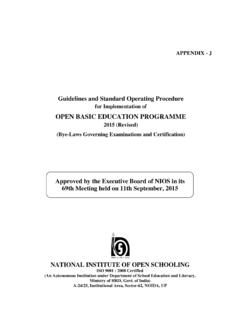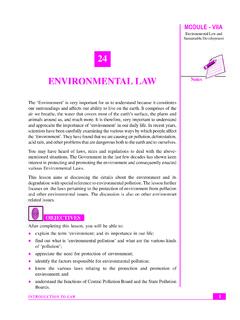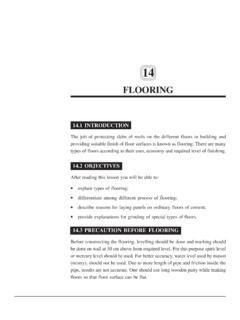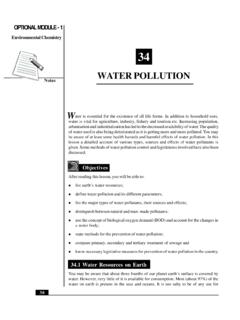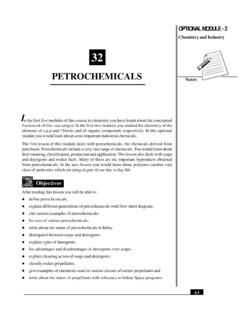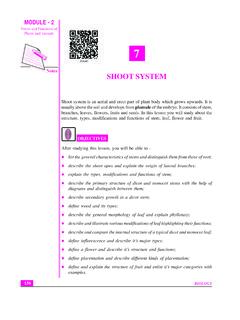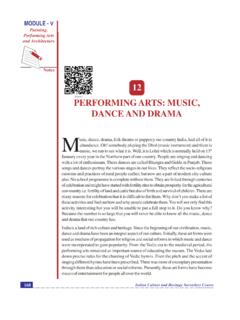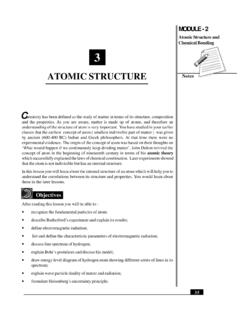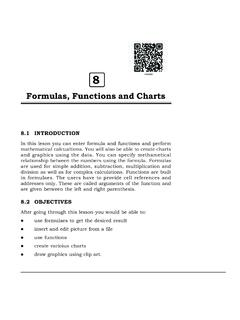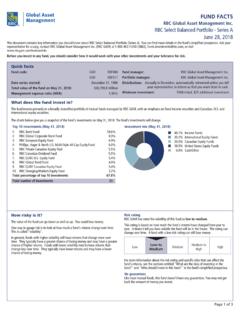Transcription of 3 FOOD GROUPS - National Institute of Open Schooling
1 HOME SCIENCEMODULE - 1 Food GroupsHome Science in Daily Life 36 Notes3 FOOD GROUPSAll of us eat different types of food everyday. There may be rice, dal, vegetables,milk, curd and fruit. We already know that all of these food items provide usnutrients, required by our body for energy, body building, repair of tissues andprotection from diseases. Can you list the various nutrients in our food? Yes, you areaware that these are proteins, carbohydrates, fats, vitamins and the previous lesson we have learnt that some food items are rich in protein whileothers may be rich in carbohydrates, fats, vitamins or minerals. For example rice isa good source of carbohydrates while dal is a good source of , it is necessary to select different food items so that our body gets all the nutrientsit requires to remain healthy. You must be wondering what a healthy meal is. Howcan we make the right selection of food in our meals?
2 In this lesson, you will learnthat selection of right food which makes a balanced meal, results in good studying this lesson, you will be able to : classify food items into different food GROUPS ; state the major nutrients and group the food items with similar nutrients forfood exchange; understand the food pyramid for choosing balanced meals; recognize the importance of meal planning and associated factors, and plan balanced meals for the family to suit every member s FOOD GROUPSYou have already learnt about the nutrients, their functions and food sources. Nowyou must be wondering what are food GROUPS . Based on the functions that areMODULE - 1 Home Science in Daily Life 37 Food GroupsHOME SCIENCEN otes performed by various types of food items available, they can be broadly divided intothree GROUPS as presented in table giving foodcarbohydrates andcereals, fats, building foodproteinspulses, milk, meat, andvitamins andfruits and vegetablesprotective foodsmineralsThere are several types of food items and each type can not be studied , they have been categorized into different food GROUPS .
3 This grouping hasbeen done on the basis of the nutrient content of each food. Let s learn about variousfood The five food group systemTable Food GroupsFood GroupsFood Major nutrients presentcereals, grains andrice, wheat, ragi, carbohydrates, proteins,their productsbajra maize, jowar vitamin B, iron, fibrebarley, rice flakes,wheat flour andbengal gram, black gram, carbohydrates, protein,legumesgreen gram, red gram lentil vitamin B, iron, fibre(whole as well as dals),cowpea, peas,rajmah,soyabean,soya nuggets, , egg andmilk, curd, paneer, cheese, proteins, fat, vitamin B,meat productschhachh, lassi, buttermilk, calcium, vitamin Askimmed chicken, protein, fat, vitamin Aliver, fish, egg,meat. HOME SCIENCEMODULE - 1 Food GroupsHome Science in Daily Life 38 Notes fruits and vegetablesfruits viz. mango, guava, orangevitamin A,papaya, banana, sweet lime,vitamin C,water, apple and vegetablesfibreviz.
4 Correct, leafy vegetableslike amaranth, spinach,coriander leaves mustardleaves and fenugreek leavesand fruits like amla vegetables:vitamin A,brinjal, lady finger,calcium, iron, fibrecapsicum,beans, onion,drumstick,cauliflowerpotato etc. carbohydrates and fibrefats and sugarfats: butter, ghee,carbohydrates , fatshydrogenated oil, ground nut,mustard, coconut oilsugarscarbohydratessugar, jaggery,honeyAll cereals like rice, wheat, ragi, bajra, maize etc. give the same nutrients that iscarbohydrates, proteins, vitamin B, iron and fibre, whereas all pulses contain protein,carbohydrates and vitamins. Similarly fruits and vegetables give vitamins and mineralswhile milk, egg and meat products are comparable in terms of their nutrient , if we substitute one food for the other in the same group, we will get almostthe same nutrients. So it will be beneficial if we learn more about each food group. MODULE - 1 Home Science in Daily Life 39 Food GroupsHOME CHARACTERISTICS OF FOOD CerealsCereals like rice, wheat and maize form themain component of our diet.
5 As they areconsumed in large quantities, they becomethe main source of energy in our diet. Wholecereals and grains contain considerableamount of fibre which, though not a nutrient,has a great importance in maintaining a healthydigestive addition to this, fibre plays a crucial role in preventing several lifestyle will learn about them later. We should eat cereals in the unrefined form to getsufficient amount of fibre. Cereals are also rich in vitamin B complex. This gets lostwhen cereals are refined, maida and polished rice. So our diet should havewhole wheat flour instead of maida and home pounded or parboiled rice instead ofpolished rice. Daliya and brown rice should also be included in our also know that most of us always eat cereals along with pulses, curd, milk, meatand vegetables. For example, dal-rice, khichri, sambar, idli, dosa, dal-bati andbiryani. Can you guess why? Yes, because when cereals are combined with pulsesor vegetables, the nutritive quality of our meal Pulses and legumesPulses and legumes like arhar, urad,rajmah and bengal gram, green gramdal are the major source of protein inIndian diets especially for have a appreciable amount ofvitamin B, calcium and have already learnt that proteinquality of pulses can be improved bycombining t hem with should be careful in including both pulses and cereals in every meal toobtain optimum quality of nuggets can be added for variety in the CerealsFig.
6 Pulses and LegumesHOME SCIENCEMODULE - 1 Food GroupsHome Science in Daily Life Milk, egg and meat productsAll of us know that milk is considered tobe the best and complete food for smallchildren. Do you know why? Yes,because it is a rich source of protein, fat,vitamin A and calcium. Curd and paneeralso contain all the nutrients butskimmed milk contains very little must have seen that while makingpaneer, we drain away the water andhence water soluble nutrients are alsodrained off. Therefore, cheese and paneer have mainly protein as a this water can be used in cooking dal and kneading dough for are a rich source of almost all nutrients except vitamin C. Eggs contain proteinsof excellent quality therefore they are specifically recommended for growingchildren, pregnant women and lactating products include meat, chicken and fish. They are a rich source of high qualityprotein, vitamin A and vitamin B.
7 As you know that a large percentage of populationin India is vegetarian, it is advisable that they consume a combination of cereals,pulses and milk products. This combination is comparable with animal foods interms of protein quality. Many of our traditional food combinations such as khichri,dal-rice, dal-roti, idli-sambar, dosa-sambar along with curd and butter milk areexcellent examples of high protein quality meals. We must continue to value thesetraditional food combinations and avoid junk QUESTIONS the food GROUPS in column A with foods in column B:Group AGroup (i)rajmah and (ii)papaya and products(iii)ragi and (iv)brinjal and (v)paneer and curd(vi)ghee and butterFig. Milk, egg and meat productsMODULE - 1 Home Science in Daily Life 41 Food GroupsHOME whether the following statements are true or false. Give reasons for thesame.(i)Cereals are the main source of energy in our body. True/Falsebecause _____.
8 (ii)We should eat cereals in refined form. True/Falsebecause _____ .(iii)Milk is considered the best food for small children. True/Falsebecause _____ .(iv)We should not consume a combination of cereals and pulses. True/Falsebecause _____ .(v)Pulses are specially recommended for vegetarian people. True/Falsebecause _____ . Fruits and VegetablesFruits: Citrus fruits such as oranges and lemons are rich in vitamin C. Amla andguava are cheap and good sources of this vitamin. Yellow fruits like mango, papayacontain carotene which is converted into vitamin A in the body. We all know thatvitamin A is very important for our eyes. Banana is a good source of iron, calciumand carbohydrates. Pomegranate is rich in iron. All fruits contain plenty of fibre,which helps in bowel movement. Dried fruits like raisins, figs, walnuts and almondsare rich in fats, iron, calcium and fibre. Locally available fruits should be preferredby us as they are fresh and leafy vegetables: Green leafy vegetables such as spinach, fenugreek, soya,amaranth (cholai) and mint are rich in carotene, calcium, iron and vitamin C.
9 Theseare abundantly available in rural areas. We can easily grow them in our kitchengarden. It is very important to include them in our daily Vegetables: Potato, sweetpotato, turnip, raddish and carrotsare some examples of roots andtubers. These vegetables are a goodsource of carbohydrates. We allknow that potato is considered to bethe master of all vegetables. It isadded in most of the vegetables. Doyou know that potato also containsvitamin C along with carbohydrates?Fig. Roots and TubersHOME SCIENCEMODULE - 1 Food GroupsHome Science in Daily Life 42 NotesNow let us discuss carrots. Carrots are rich in carotene and provide colour and tasteto a meal. You must have eaten sweet and tasty Gajar Ka Halwa , which is a verypopular sweet dish made of carrots. Other vegetables like ladys finger, beans, brinjal,gourds, tomato, cauliflower and capsicum provide variety, taste, colour along withfibre to the daily meals.
10 Some vegetables also contain an appreciable amount ofvitamin C and minerals such as iron, calcium, zinc, sodium and Fats and sugarButter, ghee, oils like mustard oil, groundnut oil, coconut oil and soya oil are the commontypes of fats consumed in India. Fats are a concentrated source of energy. Some amountof fat is needed in daily diet because they supply essential fatty acids. Besides this, somevitamins like A, D, E and K are fat soluble and important for our , jaggery and honey are sweetening agents and provide carbohydrates to thebody. Do you know that jaggery is better than sugar? Jaggery contains iron which isimportant for formation of Red Blood Cells (RBC) in our body. We should try to avoidexcessive consumption of sugar or jaggery in our daily diet. Why? Extra sugar eatenby us gets converted into fat and gets accumulated in the body and makes us QUESTIONS Jenita, Jaspreet and Victor choose their breakfast from the two meal choices givenbelow.
